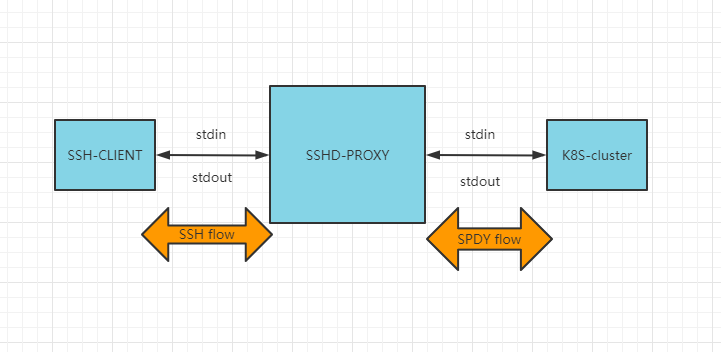

一种基于 TTY-based 的 kubernetes console 实现
source link: https://pandaychen.github.io/2022/06/01/A-KUBERNETES-CONSOLE/
Go to the source link to view the article. You can view the picture content, updated content and better typesetting reading experience. If the link is broken, please click the button below to view the snapshot at that time.

0x00 开篇
网上基于 websocket 打通 kubernetes pod 的实现非常多,但是受限于 webconsole 的不便利性,这边文章来分析下如何使用 SSH 方式打通 kubernetes 的登录。
0x01 实现思路
1、remotecommand暴露的Executor方法
我们实现的核心是打通IO(即stdin与stdout)之间的桥接,如下图:

kubernetes的client-go包提供了集群中的容器建立长连接的方法,并设置容器的 stdin,stdout 等。此package提供了基于 SPDY 协议的 Executor,其本质是一个 interface,用于和 pod 终端的流的传输及通信。Executor 接口定义了 Stream 方法,该方法会建立一个流传输的连接,直到服务端和调用端一端关闭连接,才会停止传输。(原package中给出的实现是基于HTTP-SPDY的,不适用于我们的场景,所有我们需要重新实现Stream方法)
此外,考虑到StreamOptions是Stream方法的参数,在实现Stream方法时需要填充该结构。
// Executor is an interface for transporting shell-style streams.
type Executor interface {
// Stream initiates the transport of the standard shell streams. It will transport any
// non-nil stream to a remote system, and return an error if a problem occurs. If tty
// is set, the stderr stream is not used (raw TTY manages stdout and stderr over the
// stdout stream).
Stream(options StreamOptions) error
}
func (e *streamExecutor) Stream(options StreamOptions) error{}
// StreamOptions holds information pertaining to the current streaming session:
// input/output streams, if the client is requesting a TTY, and a terminal size queue to
// support terminal resizing.
type StreamOptions struct {
Stdin io.Reader
Stdout io.Writer
Stderr io.Writer
Tty bool
TerminalSizeQueue TerminalSizeQueue
}
关于SteamOption中各个成员的作用,可以参见V1的实现;简言之,就是外部对接容器内部暴露的输入/输出。
TerminalSizeQueue结构
TerminalSizeQueue is capable of returning terminal resize events as they occur.
type TerminalSizeQueue interface {
// Next returns the new terminal size after the terminal has been resized. It returns nil when
// monitoring has been stopped.
Next() *TerminalSize
}
2、定义核心结构体,构造StreamOptions所需的成员
// TtyHandler
type PyStreamOption interface {
io.Reader //stdin
io.Writer //stdout && stderr
//io.Writer
remotecommand.TerminalSizeQueue
}
定义如上结构PyStreamOption,然后需要实例化PyStreamOption;注意实例化之后,我们必须实现该 interface的3个方法:
Read(p []byte) (int, error):从前置SSH会话(ssh.Channel)中读取数据,转发到用户侧Write(p []byte) (int, error):从前置SSH会话获取用户输入,写入podNext() *TerminalSize:即时调整终端的size
设置的目的是:
- 对接terminal的输入输出
- 实时监听窗口大小的改变并调整
这样,后续调用 Stream 方法时,只要将 StreamOptions 的 Stdin/Stdout 都设置为 PyStreamOption,Executor 会通过你定义的 Write 和 Read 方法来传输数据。
3、建立容器(连接)的方法
注意下面的CreateK8SStream方法,最后会使用remotecommand的exec.Stream方法来实现打通容器登录的过程(stdin/stdout/stderr由参数传入),即上一步定义的TtyHandler结构的相关成员:
func CreateK8SStream(option PyStreamOption) {
//...
//NewSPDYExecutor
req := cli.CoreV1().RESTClient().Post().
Resource("pods").
Name(podName).
Namespace(namespace).
SubResource("exec")
option := &corev1.PodExecOptions{
Command: cmd,
Stdin: true,
Stdout: true,
Stderr: true,
TTY: true,
}
req.VersionedParams(
option,
scheme.ParameterCodec,
)
exec, err := remotecommand.NewSPDYExecutor(config, "POST", req.URL())
if err != nil {
return err
}
//Stream
err = exec.Stream(remotecommand.StreamOptions{
Stdin: stdin, //来自option
Stdout: stdout, //来自option
Stderr: stderr, //来自option
Tty: true, //来自option,设置TTY
TerminalSizeQueue: terminalSizeQueue, //来自option
})
//...
}
接下来的思路就是如何生成一个Executor,来打通SSH到SPDY(主要还是打通上图的STDIN/STDOUT)。
0x02 参考
Related Issues not found
Please contact @pandaychen to initialize the comment
Recommend
About Joyk
Aggregate valuable and interesting links.
Joyk means Joy of geeK